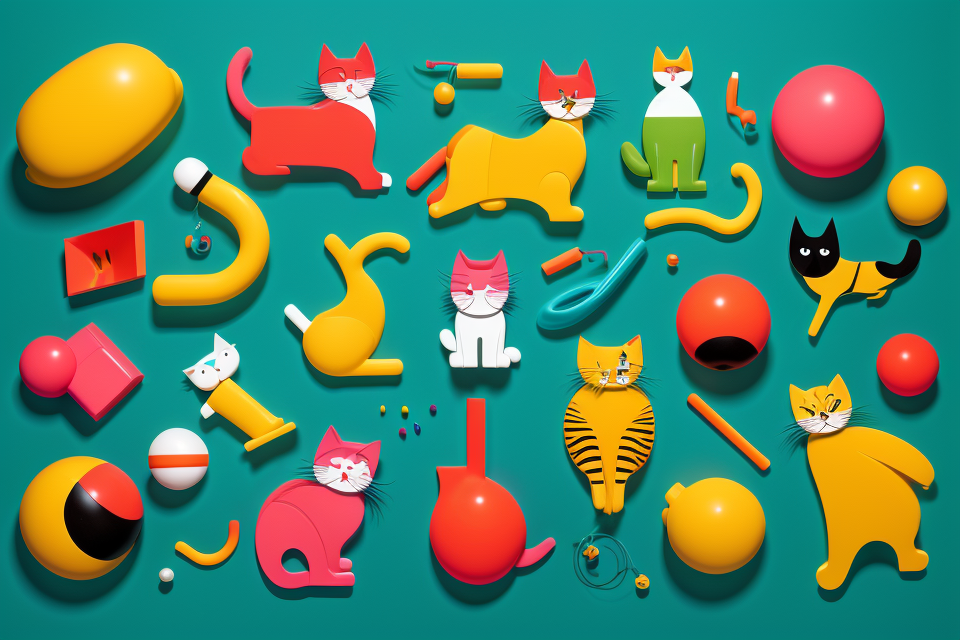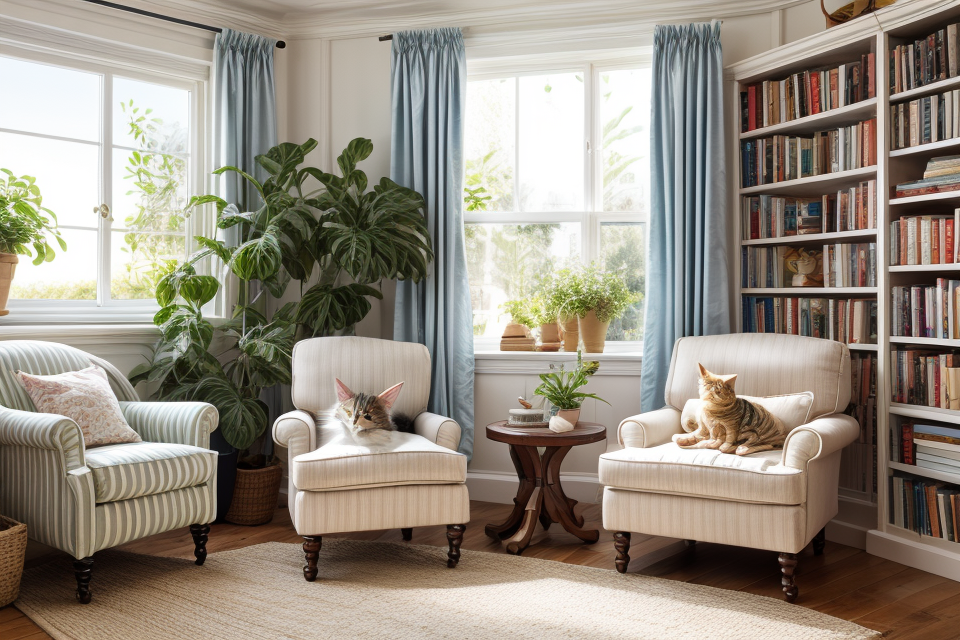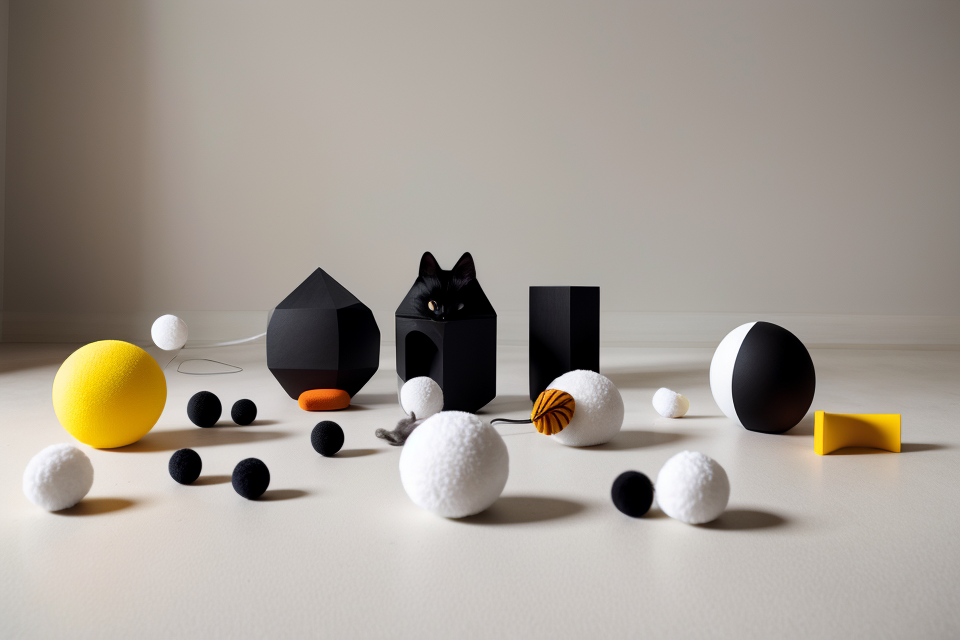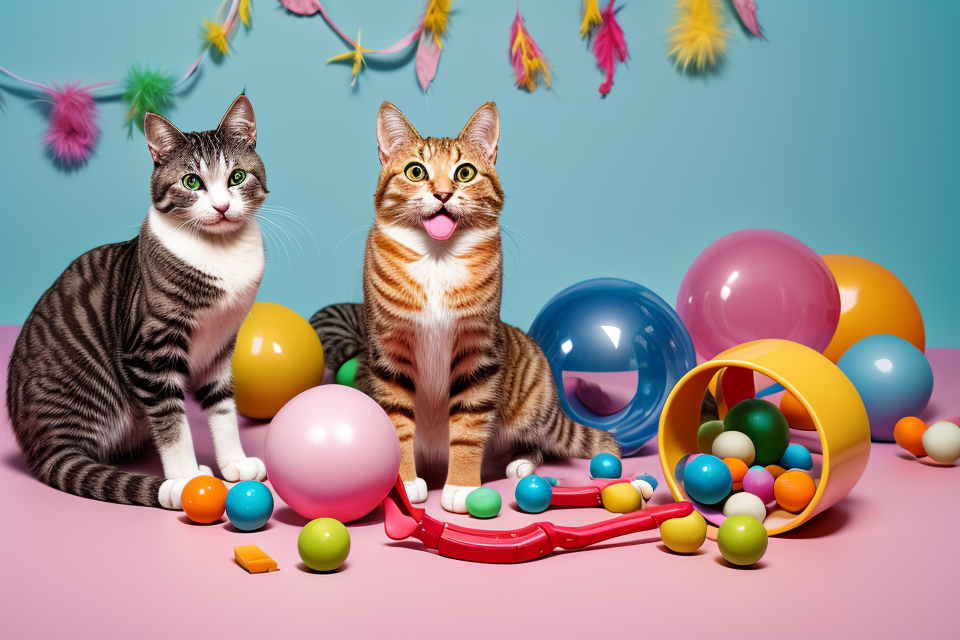Cats are known for their agility, playfulness, and independent nature. They can entertain themselves for hours, but sometimes, even the most curious of felines need a little bit of encouragement to get moving. One of the best ways to encourage your cat to play is by providing them with the right toys. In this article, we will explore the types of toys that cats absolutely love and why they are so irresistible to them. From feathers and lasers to interactive games and treats, we’ll dive into the world of cat toys and discover what makes them purr with pleasure. So, get ready to learn about the toys that will have your cat jumping, pouncing, and playing all day long!
Cats are known to be fascinated by toys that mimic the movement and sounds of small prey, such as mice or birds. Toys that move and make noise, like a small ball with a bell inside or a toy on a string, are usually a hit with cats. Cats also enjoy toys that they can hunt and pounce on, like a stuffed animal or a toy that can be hidden under a blanket or piece of furniture. Cats also enjoy interactive toys like a laser pointer or a toy that dispenses treats when the cat plays with it. It’s important to note that every cat is different and some may prefer different types of toys than others.
Factors that influence a cat’s preference for certain toys
Natural instincts
Cats have natural instincts that play a significant role in their preferences for certain toys. These instincts are rooted in their wild origins and include hunting, stalking, perching, and scratching.
Hunting and stalking
Cats are natural hunters, and this instinct is reflected in their preference for toys that simulate prey. Toys that move and make noise, such as small balls or toys with bells, are often favored by cats as they resemble the movement of small animals. Additionally, cats enjoy toys that have a distinctive smell, such as catnip, as it can stimulate their hunting instincts.
Perching and watching
Cats are also naturally inclined to perch and watch their surroundings from above. This instinct is reflected in their preference for toys that allow them to climb and perch, such as cat trees or scratching posts. These toys provide cats with a vantage point from which they can observe their environment and keep a watchful eye on their surroundings.
Scratching and climbing
Cats have a natural desire to scratch and climb, which is evident in their preference for toys that allow them to engage in these activities. Toys that have a scratching post or a climbing frame are often favored by cats as they provide an outlet for their natural scratching and climbing instincts. Additionally, toys that have a variety of textures and materials, such as sisal rope or carpet, are also preferred by cats as they allow them to scratch and climb in different ways.
Overall, a cat’s natural instincts play a significant role in their preferences for certain toys. By understanding these instincts, cat owners can choose toys that are most likely to be enjoyed by their feline companions.
Environmental factors
Availability of space
Cats love toys that can be easily accessed and moved around. Therefore, toys that are too large or bulky may not be suitable for them. It is essential to consider the available space in the home and choose toys that can fit in the environment without causing any disruption.
Presence of other cats or pets
Cats have a natural instinct to hunt and play, and their preference for toys may depend on the presence of other cats or pets in the home. If there are other cats or pets in the house, cats may prefer toys that simulate hunting or chasing, such as feathers or small toys that move quickly.
Owner’s lifestyle and routine
Cats are sensitive to their owner’s lifestyle and routine, and their preference for toys may vary depending on the owner’s habits. For example, if the owner is away from home for long periods, cats may prefer toys that provide stimulation and entertainment while they are alone, such as interactive toys or puzzle toys.
Popular types of toys that cats go crazy for
Hiding and stalking toys
Cats are natural hunters, and their playtime preferences often reflect this instinct. Hiding and stalking toys are designed to simulate the experience of hunting prey, and they are a popular choice among cat owners. These toys can be particularly engaging for indoor cats, who may not have as many opportunities to engage in natural hunting behaviors.
Examples:
Hiding and stalking toys for indoor cats
Some examples of hiding and stalking toys for indoor cats include:
- Felt mouse toys: These small, soft toys are designed to resemble mice, and they can be hidden in blankets or under furniture for cats to find.
- Hide-and-seek toys: These toys have a small opening that cats can crawl into, and they can be hidden in boxes or under furniture for cats to discover.
- Interactive toys with sounds: Some toys are designed to make sounds when touched or moved, which can be especially enticing for cats.
Hiding and stalking toys for outdoor cats
For outdoor cats, hiding and stalking toys may be more focused on simulating the experience of hunting small prey. Some examples include:
- Cat fishing pole toys: These toys have a rod with a string and a lure at the end, and cats can use their paws to bat the lure and “catch” it.
- Feather teasers: These toys have a long string with a feather on the end, and cats can chase and pounce on the feather as it moves around.
- Retractable toys with catnip: Some toys are designed to be pulled along the ground, and they can be filled with catnip to make them even more enticing for cats.
Overall, hiding and stalking toys are a great option for cats who enjoy hunting and stalking behaviors. These toys can provide mental stimulation and exercise, and they can help satisfy a cat’s natural instincts.
Perching and watching toys
Cats have a natural instinct to climb and perch themselves in high places, providing them with a strategic vantage point to observe their surroundings. Toys that allow them to do so are highly entertaining and satisfying for them. Here are some examples of perching and watching toys for both indoor and outdoor cats:
Perching and watching toys for indoor cats
- Cat trees: Cat trees are a popular choice for indoor cats as they provide multiple levels and platforms for climbing, scratching, and perching. They also offer a place for cats to hide, sleep, and play.
- Window perches: Window perches are a great option for indoor cats who love to watch birds and other animals outside. They provide a safe and secure spot for cats to perch and observe the outdoor world.
- Hanging toys: Hanging toys, such as feathers, balls, or small toys, can be attached to the ceiling or a high surface using a string or cord. This creates a fun and challenging game for cats to pounce and catch their prey.
Perching and watching toys for outdoor cats
- Outdoor enclosures: Outdoor enclosures, such as screened-in porches or patio enclosures, provide a safe and secure space for outdoor cats to perch and watch the world around them. They also offer protection from the elements and predators.
- Cat-proof birdhouses: Cat-proof birdhouses can be placed outside and filled with toys or treats. They provide a fun and challenging game for cats to play with and watch the birds from a safe distance.
- Perching posts: Perching posts, such as tree stumps or large rocks, can be placed in the yard or garden for outdoor cats to climb and perch. They offer a natural and stimulating environment for cats to exercise their hunting and climbing instincts.
Scratching and climbing toys
Cats are natural hunters and climbers, so it’s no surprise that they love toys that allow them to scratch and climb. These types of toys provide cats with the opportunity to satisfy their natural instincts and keep them entertained for hours on end. Here are some examples of scratching and climbing toys for both indoor and outdoor cats:
Scratching and climbing toys for indoor cats
- Climbing trees: Indoor cats love climbing trees, and they can be a great way to provide them with exercise and mental stimulation.
- Scratching posts: Scratching posts are a classic cat toy that provide cats with a surface to scratch and claw. They can be made from a variety of materials, including carpet, sisal rope, and cardboard.
- Hide and seek toys: Hide and seek toys, such as cardboard boxes or paper bags, can provide cats with the opportunity to scratch and climb while also using their hunting instincts to find hidden treats or toys.
Scratching and climbing toys for outdoor cats
- Climbing structures: Outdoor cats love to climb, and climbing structures, such as cat trees or enclosures, can provide them with the opportunity to do so.
- Scratching logs: Scratching logs are a great way to provide outdoor cats with a surface to scratch and claw on. They can be made from a variety of materials, including wood or rope.
- Interactive toys: Interactive toys, such as feathers or toys on strings, can be used to encourage outdoor cats to scratch and climb while also providing them with mental stimulation.
Interactive toys
Interactive toys for indoor cats
- Fishing rod toys: These toys allow indoor cats to simulate the experience of catching fish, which is a natural instinct for many cats. They can be purchased or made at home using a cardboard tube and a string.
- Hiding toys: Indoor cats love to play hide and seek, so toys that encourage this behavior are a great choice. Examples include toys with hidden compartments or toys that can be stuffed into small spaces.
- Feather teasers: These toys are great for providing cats with exercise and entertainment. They can be purchased or made at home using a feather tied to a string.
Interactive toys for outdoor cats
- Bird-shaped toys: Outdoor cats love to chase birds, so toys that resemble birds are a great choice. They can be purchased or made at home using a sock or other soft material.
- Retractable toys: Outdoor cats love to chase toys that they can retrieve, so retractable toys are a great choice. They can be purchased or made at home using a piece of string or rope.
- Scratching posts: Outdoor cats need a way to scratch and mark their territory, so scratching posts are a great choice. They can be purchased or made at home using a cardboard tube or a piece of wood.
Toys that mimic natural prey
Cats are natural hunters, and their playtime preferences reflect this instinct. Toys that mimic natural prey, such as rodents, birds, and fish, are among the most popular and beloved by cats. These toys are designed to stimulate their innate hunting skills and provide them with exercise and mental stimulation.
- Rodent toys: These toys are typically designed to resemble small rodents, such as mice or rats. They may be made of soft materials like fabric or plush, or hard materials like plastic or metal. Some rodent toys are filled with catnip, which can make them even more appealing to cats.
- Bird toys: Bird toys are often designed to mimic the movement and appearance of birds. They may be suspended from a string or attached to a stick, and they may make noise or move in a way that resembles a bird in flight. Cats find these toys particularly appealing and may use them to practice their hunting skills.
- Fish toys: Fish toys are typically designed to resemble small fish or other aquatic animals. They may be made of soft materials like fabric or plush, or hard materials like plastic or metal. Some fish toys are designed to float, while others are designed to move through the water like a real fish. Cats find these toys appealing and may use them to practice their hunting skills.
Overall, toys that mimic natural prey are a popular choice for cats because they appeal to their natural instincts and provide them with exercise and mental stimulation. These toys can be an enjoyable and engaging part of a cat’s playtime routine.
How to choose the right toys for your cat
Take into account your cat’s environment and your lifestyle
When choosing toys for your cat, it’s important to consider their environment and your lifestyle. Here are some factors to keep in mind:
- Indoor vs. outdoor cats: If your cat spends most of their time indoors, they may prefer toys that they can play with on their own, such as puzzle toys or interactive toys that can be played with remotely. On the other hand, if your cat spends time outdoors, they may enjoy toys that mimic prey, such as small stuffed animals or toys that move on their own.
- Age and activity level: Cats have different play preferences based on their age and activity level. Kittens and young cats may enjoy toys that encourage jumping, climbing, and pouncing, while older cats may prefer more low-key toys that they can bat at or play with using their paws.
- Personal interests: Some cats may have specific interests or preferences when it comes to toys. For example, some cats may enjoy toys that make noise, while others may prefer toys that have a particular texture or smell. Pay attention to your cat’s preferences and try to choose toys that they will enjoy playing with.
- Your availability: If you work long hours or have a busy schedule, you may want to choose toys that your cat can play with on their own, such as puzzle toys or toys that dispense treats. On the other hand, if you have more time to spend with your cat, you may want to choose toys that encourage interactive play, such as fetch or tug-of-war.
By taking these factors into account, you can choose toys that are appropriate for your cat’s age, interests, and lifestyle, and provide them with the enrichment and entertainment they need to stay happy and healthy.
Observe your cat’s reactions to different toys
When it comes to choosing the right toys for your feline friend, one of the most effective ways to determine their preferences is by observing their reactions to different toys. Here are some tips to help you do just that:
- Present a variety of toys: Start by gathering a selection of toys that cater to your cat’s natural instincts and preferences. This might include toys that mimic prey, such as feathers, small animals, or soft plush toys. You should also consider toys that encourage movement and play, like balls, ropes, and scratching posts.
- Introduce the toys gradually: Instead of overwhelming your cat with a bunch of toys all at once, introduce them gradually. This will give your cat time to get used to each toy and allow you to observe their reactions more clearly.
- Watch for body language: Pay attention to your cat’s body language as they interact with each toy. Are they pouncing, swatting, or chasing the toy? Do they seem interested or bored? Take note of their tail movement, too, as a wagging tail can indicate excitement and engagement.
- Consider your cat’s age and ability: Your cat’s age and physical ability can impact their preferences when it comes to toys. For example, older cats may prefer lower-impact toys that are easier to handle, while younger cats may enjoy more active and interactive toys.
- Take note of preferences: Over time, you’ll start to notice which toys your cat seems to enjoy the most. Pay attention to these preferences and incorporate more of those types of toys into their playtime routine.
By observing your cat’s reactions to different toys, you’ll be able to make informed decisions about which types of toys will provide the most enjoyment and enrichment for your feline friend.
Introduce new toys gradually and monitor your cat’s behavior
Cats are naturally curious creatures, and they love toys that allow them to engage their hunting instincts and exercise their natural behaviors. However, it’s important to introduce new toys gradually and monitor your cat’s behavior to ensure that they are having fun and not becoming overwhelmed or stressed. Here are some tips for introducing new toys to your cat:
- Start with one new toy at a time: Introduce a new toy to your cat slowly and give them time to get used to it. This will help prevent overwhelm and allow your cat to focus on the new toy without being distracted by other toys.
- Observe your cat’s behavior: Watch your cat as they play with the new toy and pay attention to their body language and behavior. If they seem hesitant or uninterested, try introducing the toy again later or try a different type of toy.
- Rotate toys frequently: Cats can become bored with the same toys over time, so it’s important to rotate their toys frequently to keep them engaged and interested. Try rotating toys every few days to keep your cat excited and engaged.
- Consider your cat’s preferences: Every cat is different and has their own preferences when it comes to toys. Some cats love feathers, while others prefer plush toys or interactive toys. Pay attention to your cat’s preferences and choose toys that they are most likely to enjoy.
By introducing new toys gradually and monitoring your cat’s behavior, you can ensure that they are having fun and staying engaged and interested in their toys.
FAQs
1. What types of toys do cats absolutely love?
Cats have a natural instinct to hunt and play, so they tend to love toys that simulate hunting and provide mental stimulation. Some popular toys that cats go crazy for include:
* Fishing pole toys: These toys consist of a long stick with a toy fish dangling from the end. Cats love to use their paws to swat the toy and watch it move.
* Feather toys: Cats love to chase and pounce on feathers, so feather toys are a great option for providing exercise and mental stimulation.
* Hiding toys: Cats love to hide and seek, so toys that can be hidden and revealed, such as hidden treats or stuffed animals, can be a great source of entertainment.
* Interactive toys: Toys that can be played with using human interaction, such as laser pointers or finger puppets, can be a great way to bond with your cat and provide mental stimulation.
2. Are there any toys that cats don’t like?
While most cats enjoy the types of toys mentioned above, there are some toys that may not be as appealing to them. For example, cats may not be interested in toys that are too loud or that move too quickly, as this can be overstimulating. Additionally, some cats may not be interested in toys that are too soft or that don’t provide enough of a challenge. It’s important to observe your cat’s preferences and adjust the type of toys you offer accordingly.
3. How often should I replace my cat’s toys?
Cats can become bored with their toys relatively quickly, so it’s important to regularly rotate their toys to keep them engaged. A good rule of thumb is to replace your cat’s toys every few months, or more frequently if they seem to be losing interest. Additionally, it’s important to monitor your cat’s toys for signs of wear and tear, and to dispose of any toys that are damaged or showing signs of wear.
4. Can I use human toys as cat toys?
While some human toys can be suitable for cats, it’s important to be mindful of any small parts that may be easily removable and ingested by the cat. It’s also important to consider whether the toy is appropriate for the age and play style of your cat. For example, younger cats may be more interested in toys that are interactive and encourage movement, while older cats may prefer more low-key toys that they can bat at.
5. Are there any safety concerns with cat toys?
Yes, there are some safety concerns to keep in mind when selecting cat toys. For example, avoid toys that have small parts that can be easily removed and ingested by the cat, as this can pose a choking hazard. Additionally, avoid toys that are made of materials that can be easily shredded or ingested, as this can also pose a choking hazard. It’s also important to monitor your cat’s playtime and intervene if necessary to prevent any accidents or injuries.



